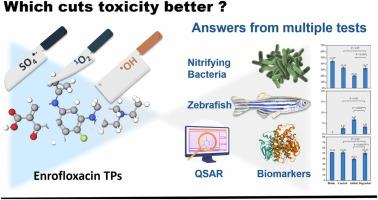单线态氧对恩诺沙星的解毒潜力高于硫酸根自由基和羟基自由基
IF 11.3
1区 环境科学与生态学
Q1 ENGINEERING, ENVIRONMENTAL
引用次数: 0
摘要
在自由基和非自由基反应物质(RS)的帮助下,高级氧化过程可以有效地降解包括抗生素在内的新兴有机污染物,但可能产生有毒转化产物(TPs)。然而,常见的RS的解毒能力尚未得到很好的阐明。本研究比较了恩诺沙星(ENR)与三种以rs为主的体系:1O2、SO4•-+•OH、•OH的解毒作用。用多种方法评估了这些系统产生的ENR TPs的毒性。研究发现,在微生物呼吸抑制、斑马鱼胚胎发育毒性以及3种典型分子生物标志物(活性氧(ROS)、乳酸脱氢酶(LDH)和谷胱甘肽s -转移酶(GST))方面,以o2为主导的系统解毒ENR的效果优于其他系统。基于UPLC-QTOF-MS/MS预测的ENR TPs的化学结构,毒性预测工具(T.E.S.T)显示,以o2为主导的体系比其他体系产生的TPs更无害。本研究结果强调了以o2为主导的系统在有机污染物解毒方面的巨大潜力。本文章由计算机程序翻译,如有差异,请以英文原文为准。

Singlet oxygen presenting a higher detoxification potential on enrofloxacin than sulfate and hydroxyl radicals
With the aid of radical and non-radical reactive species (RS), advanced oxidation processes can efficiently degrade emerging organic contaminants including antibiotics but may generate toxic transformation products (TPs). However, the detoxification capacity of popular RS has not been well elucidated. This study compared the detoxification of enrofloxacin (ENR) with three RS-dominated systems: 1O2, SO4•-+•OH, •OH. The toxicity of ENR TPs generated from those systems was evaluated with multiple methods. It was found that the 1O2-dominated system detoxified ENR more effectively than the other systems in terms of microbial respiratory inhibition, developmental toxicity in zebrafish embryos, and three typical molecular biomarkers, including reactive oxygen species (ROS), and lactate dehydrogenase (LDH), and glutathione S-transferase (GST). Based on their chemical structures of ENR TPs projected with UPLC-QTOF-MS/MS, the toxicity prediction tool (T.E.S.T) revealed that the 1O2-dominated system led to more harmless TPs than the others. The results of this study underscore the great potential of 1O2-dominated system in the detoxification of organic contaminants.
求助全文
通过发布文献求助,成功后即可免费获取论文全文。
去求助
来源期刊

Journal of Hazardous Materials
工程技术-工程:环境
CiteScore
25.40
自引率
5.90%
发文量
3059
审稿时长
58 days
期刊介绍:
The Journal of Hazardous Materials serves as a global platform for promoting cutting-edge research in the field of Environmental Science and Engineering. Our publication features a wide range of articles, including full-length research papers, review articles, and perspectives, with the aim of enhancing our understanding of the dangers and risks associated with various materials concerning public health and the environment. It is important to note that the term "environmental contaminants" refers specifically to substances that pose hazardous effects through contamination, while excluding those that do not have such impacts on the environment or human health. Moreover, we emphasize the distinction between wastes and hazardous materials in order to provide further clarity on the scope of the journal. We have a keen interest in exploring specific compounds and microbial agents that have adverse effects on the environment.
 求助内容:
求助内容: 应助结果提醒方式:
应助结果提醒方式:


